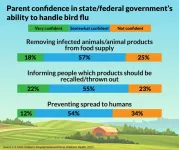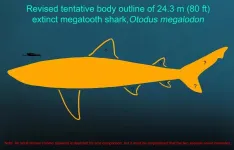(Press-News.org) Gene mutations caused by exposure to certain chemical compounds have been linked to the development of gliomas, the most common type of malignant brain tumor. New research reveals that among patients with gliomas, these mutations are more common in firefighters than in individuals with other occupations. The findings are published by Wiley online in CANCER, a peer-reviewed journal of the American Cancer Society.
The gene mutations of interest in this study make up a mutational pattern or “signature” that other investigators previously associated with exposure to haloalkanes, which are used in flame retardants, fire extinguishants, refrigerants, and other products.
“As firefighters have exposure to such chemical agents, we examined mutational signatures in glioma brain tumors diagnosed in persons who worked as firefighters versus those who did not,” said senior author Elizabeth B. Claus, MD, PhD, a professor at the Yale University School of Public Health and attending neurosurgeon at Mass General Brigham.
Among 35 participants in the University of California Adult Glioma Study, 17 had an occupational history of firefighting. Compared with the other 18 participants, firefighters were more likely to have the haloalkane-associated mutational signature, especially if they had been firefighters for many years. Among non-firefighters, the mutational signature was more likely in those with occupations that also possibly exposed them to haloalkanes, such as car painting and machine maintenance.
“Our study provides preliminary data but will need confirmation in a larger data set and across a wider range of occupations,” said Dr. Claus. “Identifying exposure to such mutational agents is important to inform public health intervention strategies and pinpoint occupational hazards that may be avoidable.”
Additional information
NOTE: The information contained in this release is protected by copyright. Please include journal attribution in all coverage. A free abstract of this article will be available via the CANCER Newsroom upon online publication. For more information or to obtain a PDF of any study, please contact: Sara Henning-Stout, newsroom@wiley.com
Full Citation:
“Glioma mutational signatures associated with haloalkane exposure are enriched in firefighters.” Vincent L. Cannataro, Paige M. Bracci, Jennie W. Taylor, Lucie McCoy, Terri Rice, Helen M. Hansen, Anne E. Heffernan, Joseph Wiemels, John Wiencke, Margaret Wrensch, and Elizabeth B. Claus. CANCER; Published Online: March 10, 2025 (DOI: 10.1002/cncr.35732).
URL Upon Publication: http://doi.wiley.com/10.1002/cncr.35732
Author Contact: The International Low Grade Glioma Registry/OPTIMUM, Yale University, at glioma@yale.edu
About the Journal
CANCER is a peer-reviewed publication of the American Cancer Society integrating scientific information from worldwide sources for all oncologic specialties. The objective of CANCER is to provide an interdisciplinary forum for the exchange of information among oncologic disciplines concerned with the etiology, course, and treatment of human cancer. CANCER is published on behalf of the American Cancer Society by Wiley and can be accessed online. Follow CANCER on X @JournalCancer and Instagram @ACSJournalCancer, and stay up to date with the American Cancer Society Journals on LinkedIn.
About Wiley
Wiley is one of the world’s largest publishers and a trusted leader in research and learning. Our industry-leading content, services, platforms, and knowledge networks are tailored to meet the evolving needs of our customers and partners, including researchers, students, instructors, professionals, institutions, and corporations. We empower knowledge-seekers to transform today’s biggest obstacles into tomorrow’s brightest opportunities. For more than two centuries, Wiley has been delivering on its timeless mission to unlock human potential. Visit us at Wiley.com. Follow us on Facebook, X, LinkedIn and Instagram.
END
Do firefighters face a higher brain cancer risk associated with gene mutations caused by chemical exposure?
Study suggests a greater likelihood of haloalkane-associated mutations in firefighters with gliomas than in other patients with this type of brain cancer
2025-03-10
ELSE PRESS RELEASES FROM THIS DATE:
Less than half of parents think they have accurate information about bird flu
2025-03-10
With soaring egg prices and ongoing bird flu headlines, many parents are uncertain about the risks and facts surrounding the virus, a national poll suggests.
Most parents say they don’t know if there have been cases of bird flu in their state, and less than half feel that they are able to find accurate and current information about it, according to the University of Michigan Health C.S. Mott Children’s Hospital National Poll on Children’s health.
“Many parents may hear about bird flu in the news but don’t feel well-informed or know if they should be taking action to protect their families,” said Mott Poll Co-Director Sarah Clark, M.P.H.
“This ...
Common approaches for assessing business impact on biodiversity are powerful, but often insufficient for strategy design
2025-03-10
A University of Oxford study has determined that the widely used tools available to businesses for assessing their biodiversity impacts depend on broad assumptions and can have large uncertainties that are poorly understood or communicated. If used appropriately, they can be powerful tools to help guide effective action to address biodiversity loss – but if not, they can lead to misguided effort and can be insufficient for robust biodiversity strategy design.
Businesses across a range of industries and sectors are under growing pressure to develop biodiversity strategies that not only minimise their negative impacts but ...
Can a joke make science more trustworthy?
2025-03-10
Politicians learned this lesson a long time ago: a well-placed joke is a valuable tool for capturing public attention and building trust. Scientists, however, are much more reluctant to use humor when engaging in science communication. They may fear that a lighthearted approach could make them seem less authoritative and, consequently, make scientific findings appear less credible.
The good news, however, is that science itself seems to contradict this assumption. A new study led by Alexandra Lynn Frank, a ...
Hiring strategies
2025-03-10
Krapivsky drew inspiration from the famous “secretary problem” or “optimal marriage problem”. In one of its many versions, a princess must choose her future husband from a pool of 100 candidates at a grand reception. However, strict rules apply: she may meet only one suitor at a time and has limited time to get to know him. At the end of each encounter, she must decide immediately whether to accept or reject the suitor. She cannot revisit previous candidates, nor can she ask any of them to wait while she considers others. How can the princess hope to make the best choice?
The secret lies in a number: 37, to be precise (raise your hand if you ...
Growing consumption of the American eel may lead to it being critically endangered like its European counterpart
2025-03-10
High demand for eel combined with decline in stock have resulted in soaring prices for this food item, which in many cultures, is considered a delicacy. This has fuelled a concern globally as the prized food item is now being illegally traded from Europe to Asia.
Current research has focused on the critically endangered Anguilla anguilla, commonly known as the European eel. While its export outside the European Union is tightly regulated, large quantities of A. anguilla juveniles continue to be smuggled ...
KIST develops high-performance sensor based on two-dimensional semiconductor
2025-03-10
Next-generation imaging technology is rapidly expanding beyond smartphones into intelligent devices, robotics, extended reality (XR) devices, healthcare, CCTV, and various other industries. At the core of these technological advances are highly efficient, ultra-compact image sensors that convert light signals into electrical signals. Image sensors capture and process visual information from objects and environments, enabling precise reconstruction of their shape, size, and spatial position.
Currently, commercial image sensors are primarily based on silicon semiconductors. ...
New study links sleep debt and night shifts to increased infection risk among nurses
2025-03-10
A new study examining the effects of sleep patterns and shift work on the immune system has found that sleep debt and night shifts increase the risk of several common infections in nurses.
Modern society relies on shift work, which requires employees to work outside of traditional hours. While essential in sectors such as healthcare, growing evidence suggests that these work patterns may negatively impact worker’s health.
This study, which analysed self-reported data from 1,335 Norwegian nurses, found that shift work – particularly night shifts – was associated with a higher risk of several infections, including the ...
Megalodon’s body size and form uncover why certain aquatic vertebrates can achieve gigantism
2025-03-09
CHICAGO — A new scientific study provides many new insights into the biology of the prehistoric gigantic shark, Megalodon or megatooth shark, which lived nearly worldwide 15-3.6 million years ago. Paleobiology professor Kenshu Shimada of DePaul University led the study along with 28 other shark, fossil, and vertebrate anatomy experts around the globe. Findings from the study will be published in the journal “Palaeontologia Electronica.”
Formally called Otodus megalodon, it is primarily known only from its serrated teeth, vertebrae, ...
A longer, sleeker super predator: Megalodon’s true form
2025-03-09
The megalodon has long been imagined as an enormous great white shark, but new research suggests that perception is all wrong. The study finds the prehistoric hunter had a much longer body—closer in shape to a lemon shark or even a large whale.
The study team, which included researchers from University of California, Riverside and across the globe, used a novel approach to estimate the shark’s total body length, moving beyond traditional methods that rely primarily on tooth size. By examining megalodon’s vertebral column and comparing ...
Walking, moving more may lower risk of cardiovascular death for women with cancer history
2025-03-09
Research Highlights:
Increased physical activity including taking more daily steps was linked to a lower risk of death from cardiovascular disease among postmenopausal women with a history of cancer.
The study found that engaging in one hour per day of moderate to vigorous physical activity reduced participants’ risk of death from any cause by 40% and risk of death from cardiovascular disease by 60%.
Each additional 2,500 steps per day for a participant was associated with a 34% reduction in risk of death from cardiovascular disease.
Note: The study featured in this news release is a research abstract. Abstracts presented ...
LAST 30 PRESS RELEASES:
Fame itself may be critical factor in shortening singers’ lives
Daily coffee drinking may slow biological ageing of people with major mental illness
New highly efficient material turns motion into power – without toxic lead
The DEVILS in the details: New research reveals how the cosmic landscape impacts the galaxy lifecycle
After nearly 100 years, scientists may have detected dark matter
Gender imbalance hinders equitable environmental governance, say UN scientists
Six University of Tennessee faculty among world’s most highly cited researchers
A type of immune cell could hold a key to preventing scar tissue buildup in wounds
Mountains as water towers: New research highlights warming differences between high and low elevations
University of Tennessee secures $1 million NSF grant to build semiconductor workforce pipeline
Biochar shows powerful potential to build cleaner and more sustainable cities worldwide
UT Health San Antonio leads $4 million study on glucagon hormone’s role in diabetes, obesity
65-year-old framework challenged by modern research
AI tool helps visually impaired users ‘feel’ where objects are in real time
Collaborating minds think alike, processing information in similar ways in a shared task
Routine first trimester ultrasounds lead to earlier detection of fetal anomalies
Royal recognition for university’s dementia work
It’s a bird, it’s a drone, it’s both: AI tech monitors turkey behavior
Bormioli Luigi renews LionGlass deal with Penn State after successful trial run
Are developers prepared to control super-intelligent AI?
A step toward practical photonic quantum neural networks
Study identifies target for disease hyper progression after immunotherapy in kidney cancer
Concordia researchers identify key marker linking coronary artery disease to cognitive decline
HER2-targeted therapy shows promising results in rare bile duct cancers
Metabolic roots of memory loss
Clinical outcomes and in-hospital mortality rate following heart valve replacements at a tertiary-care hospital
Too sick to socialize: How the brain and immune system promote staying in bed
Seal milk more refined than breast milk
Veterans with cardiometabolic conditions face significant risk of dying during extreme heat events
How plants search for nutrients
[Press-News.org] Do firefighters face a higher brain cancer risk associated with gene mutations caused by chemical exposure?Study suggests a greater likelihood of haloalkane-associated mutations in firefighters with gliomas than in other patients with this type of brain cancer




